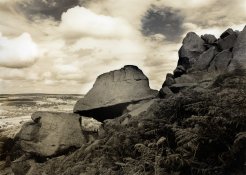I'm not that experienced with darkroom intricacies but I thought I was getting better as far as dodging and burning go, until I came to the attached image. I can't for the life of me burn in the sky (which needs an extra 10 secs on top of the base exposure) without leaving the bright halos around the edge of the two main rock formations.
In my latest attempts I have cut a bit of card in the same shape as the line between the sky and the rest of the scene and have got slightly better results than before, but I;m still not happy. Is there something I am doing wrong or do I just need more practice with this kind of thing?
In my latest attempts I have cut a bit of card in the same shape as the line between the sky and the rest of the scene and have got slightly better results than before, but I;m still not happy. Is there something I am doing wrong or do I just need more practice with this kind of thing?











